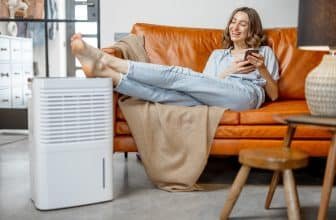UV-C Technology: How UV Air Purifiers Kill Germs and Viruses
UV-C technology is a type of ultraviolet light that is commonly used to disinfect surfaces and air. It is a powerful tool in the fight against germs and viruses, as it can render microorganisms such as bacteria and viruses harmless. UV-C technology works by damaging the genetic material of these microorganisms, preventing them from reproducing and causing infections.

One of the most popular applications of UV-C technology is in air purifiers. UV air purifiers use UV-C lamps to kill germs and viruses in the air, making it safer to breathe. These air purifiers work by drawing air through a filter that traps particles such as dust and pollen, and then exposing the air to UV-C light to kill any remaining microorganisms. UV air purifiers are particularly effective against airborne pathogens such as the flu virus, which can spread through the air and cause widespread infection.
UV-C Purifiers: A Light-Based Solution to Killing Airborne Germs and Viruses
- UV-C technology is a powerful tool in the fight against germs and viruses, as it can render microorganisms such as bacteria and viruses harmless.
- UV air purifiers are an effective way to improve indoor air quality by killing germs and viruses in the air.
- While UV-C technology is generally safe, it is important to follow safety guidelines and use it properly to avoid potential health risks.
Understanding UV-C Technology
Basics of UV Light
Ultraviolet (UV) light is a type of electromagnetic radiation that has a wavelength shorter than that of visible light, but longer than X-rays. UV light is divided into three categories based on their wavelengths: UV-A, UV-B, and UV-C. UV-C light has the shortest wavelength and the highest energy, making it the most effective at killing microorganisms such as bacteria and viruses.
Mechanisms of UV-C Disinfection
UV-C light works by damaging the DNA and RNA of microorganisms, preventing them from reproducing and rendering them harmless. This process is called germicidal irradiation. UV-C radiation is absorbed by the DNA and RNA of microorganisms, causing the formation of covalent bonds between adjacent nucleotides, which disrupts the normal functioning of the genetic material. This leads to the death of the microorganism or renders it unable to reproduce.
UV-C Light and Microorganism Inactivation
Research has shown that UV-C light can effectively inactivate a wide range of microorganisms, including bacteria, viruses, and fungi. The effectiveness of UV-C light in killing microorganisms depends on several factors, including the intensity of the light, the duration of exposure, and the distance between the light source and the microorganism.
UV air purifiers use UV-C lamps to generate UV-C light that inactivates microorganisms in the air. The air is drawn into the purifier, exposed to the UV-C light, and then released back into the room. The UV-C light inactivates any microorganisms present in the air, rendering them harmless.
UV air purifiers are an effective way to improve indoor air quality by removing harmful microorganisms from the air. However, it is important to note that UV-C light can also be harmful to humans and can cause skin and eye damage. Therefore, it is important to use UV air purifiers in a safe and controlled manner.
UV-C Air Purifiers and Indoor Air Quality
UV-C air purifiers are becoming increasingly popular as people look for ways to improve indoor air quality. These air purifiers use ultraviolet light to neutralize pathogens, including bacteria and viruses, which can lead to a healthier living environment.
Role in Improving Air Quality
Indoor air quality can be a major concern for many people, especially those who suffer from allergies or asthma. UV-C air purifiers can play an important role in improving air quality by removing harmful microorganisms from the air. According to a systematic review published in 2021, UV air purifiers that use a HEPA filter may be effective at removing bacteria from the air.
Benefits for Allergy and Asthma Sufferers
UV-C air purifiers can be particularly beneficial for those who suffer from allergies or asthma. These air purifiers can help to remove allergens from the air, such as pet dander and pollen, which can trigger allergy symptoms. In addition, UV-C air purifiers can help to reduce the presence of mold spores in the air, which can be a major concern for those with allergies or asthma.
Comparing UV Air Purifiers with HEPA Filters
HEPA filters are another popular type of air purifier that can be used to improve indoor air quality. While both UV-C air purifiers and HEPA filters can be effective at removing harmful microorganisms from the air, they work in different ways. HEPA filters use a dense filter material to trap particles, while UV-C air purifiers use ultraviolet light to neutralize pathogens.
In conclusion, UV-C air purifiers can be an effective way to improve indoor air quality and reduce the presence of harmful microorganisms in the air. While they may not be suitable for everyone, they can be particularly beneficial for those who suffer from allergies or asthma. When comparing UV air purifiers with HEPA filters, it is important to consider the specific needs of your living environment to determine which type of air purifier is right for you.
Effectiveness Against Pathogens
UV-C technology has been proven to be highly effective against a wide range of pathogens, including viruses and bacteria. By emitting short-wavelength ultraviolet light, UV air purifiers can render microorganisms such as bacteria and viruses harmless.
Viruses and Coronavirus
Recent studies have shown that UV-C technology is effective in killing viruses, including the coronavirus. According to a systematic review of studies published in the National Center for Biotechnology Information (NCBI), UV-based technologies have high virucidal potential against SARS-CoV-2, the virus that causes COVID-19. The study supports the use of UV technology for infection prevention and control in hospital and community settings. UV-C light is just as novel to SARS-CoV-2 as the virus is to humans, making it an effective tool in the fight against the pandemic.
Bacteria and Mold
UV-C technology is also effective in killing bacteria and mold. According to a study published in the NCBI, UVA light effectively reduces bacteria and viruses including coronavirus-229E. The study suggests that UVA may provide a safe and effective treatment for infectious diseases of internal viscera. UV air purifiers can also reduce the growth of mold and other fungi, which can cause respiratory problems and allergies.
Reduction of Airborne Microbes
UV air purifiers can help reduce the number of airborne microbes in indoor spaces. According to a report by the Centers for Disease Control and Prevention (CDC), UVGI technologies can be used to disinfect the air in hospitals, schools, and other public spaces. UV air purifiers can help reduce the spread of infectious diseases such as tuberculosis and measles, as well as drug-resistant bacteria. By using UV technology, it is possible to create a safer and healthier indoor environment.
Safety and Usage Considerations
Potential Risks of UV-C Exposure
While UV-C light is effective at killing bacteria and viruses, it can also be harmful to humans if proper safety precautions are not followed. Exposure to UV-C light can cause photokeratitis, a painful inflammation of the cornea, as well as phototoxicity, which can damage skin cells and cause sunburn. Long-term exposure to UV-C light can also increase the risk of skin cancer.
Best Practices for Safe Operation
To minimize the risk of exposure to UV-C light, it is important to follow best practices for safe operation. This includes wearing protective gear such as gloves and goggles, and ensuring that the UV-C light is not directed towards the eyes or skin. It is also important to follow manufacturer instructions for safe use and maintenance of the UV-C air purifier.
Innovations in UV-C Safety
In recent years, there have been innovations in UV-C safety that have made it safer for use around humans. Far-UVC light, for example, has a shorter wavelength than traditional UV-C light and is thus less harmful to human cells. This makes it safe for use in public spaces such as hospitals and schools, where there is a higher risk of exposure to bacteria and viruses.
Overall, while UV-C air purifiers are effective at killing bacteria and viruses, it is important to follow proper safety precautions to minimize the risk of exposure to harmful UV-C light. By following best practices for safe operation and staying up-to-date on the latest innovations in UV-C safety, it is possible to use UV-C air purifiers in a safe and effective manner.
Integrating UV-C Technology in Daily Life
UV-C technology has been proven effective in killing germs and viruses, making it an important tool in the fight against the spread of infections. Integrating UV-C technology in daily life can help keep homes, public spaces, and healthcare facilities safe from harmful microorganisms.
Residential Applications
UV-C technology can be integrated into residential HVAC systems to help purify the air in homes. UV air purifiers can be installed in air ducts to kill bacteria and viruses as they pass through the system. This can be particularly useful during flu season or in homes where someone is sick. It is important to note that while UV-C technology can help reduce the spread of germs, it is not a substitute for good hygiene practices.
Commercial and Public Spaces
Public spaces such as schools, offices, and restaurants can also benefit from integrating UV-C technology. UV air purifiers can be installed in HVAC systems to help disinfect the air in these spaces. Additionally, UV-C technology can be used to disinfect surfaces such as door handles, countertops, and tables. This can help reduce the spread of infections during a pandemic or flu season.
UV-C in Healthcare Settings
UV-C technology has long been used in healthcare settings to help disinfect surfaces and equipment. During the COVID-19 pandemic, UV-C technology has been used to disinfect masks and other personal protective equipment (PPE) for reuse. Additionally, UV air purifiers can be used in hospital rooms to help reduce the spread of infections.
It is important to note that while UV-C technology can be effective in killing germs and viruses, it should not be relied upon as the sole method of disinfection. Good hygiene practices, such as hand washing and surface cleaning, should still be followed.
Advancements and Future Directions
Research and Development
The use of UV-C technology to kill germs and viruses has been a subject of research and development for several decades. With the recent COVID-19 pandemic, there has been a renewed interest in this technology. Researchers are exploring ways to improve the efficiency and safety of UV-C devices. One area of research is the use of far-UVC light, which has been shown to be effective in killing viruses while posing minimal risk to human health.
Scientific reports have shown that UV-C technology is effective in destroying microorganisms such as bacteria and viruses. However, there is ongoing research to improve the technology’s effectiveness, especially against airborne viruses.
Regulatory Perspectives
The Environmental Protection Agency (EPA) regulates the use of UV-C devices in the United States. The agency has established guidelines for the safe use of these devices, including the maximum allowable exposure levels for humans. UV-C devices that meet these guidelines are considered safe for use in occupied spaces.
Regulatory bodies in other countries also have guidelines for the use of UV-C devices. However, there is a need for global standards to ensure the safe and effective use of these devices.
Emerging UV-C Technologies
One emerging technology is upper-room UVGI, which uses UV-C lamps mounted on the ceiling to disinfect the air in a room. This technology is particularly useful in spaces where people congregate, such as schools and hospitals.
Another emerging technology is the use of sunlight to disinfect surfaces. Researchers are exploring ways to harness the power of sunlight to kill germs and viruses on surfaces. This technology has the potential to be used in outdoor spaces, such as parks and playgrounds.
Advancements in UV-C technology have the potential to revolutionize the way we disinfect our homes, offices, and public spaces. As research continues, we can expect to see more innovative uses of this technology to keep us safe from harmful microorganisms.
Frequently Asked Questions
What are the potential side effects of using a UV air purifier?
UV air purifiers are generally safe to use, but prolonged exposure to UV-C light can cause eye and skin irritation. It is important to follow the manufacturer’s instructions and avoid direct exposure to the UV-C light.
How does ultraviolet germicidal irradiation (UVGI) work in air purifiers?
UVGI technology uses short-wavelength ultraviolet light to kill or inactivate microorganisms such as bacteria and viruses. When air containing these microorganisms passes through a UV-C air purifier, the UV-C light damages their DNA and RNA, preventing them from reproducing and rendering them harmless.
What is the effectiveness of UV-C light in inactivating airborne pathogens?
UV-C light has been shown to be effective in inactivating a wide range of airborne pathogens, including bacteria and viruses. Studies have demonstrated that UV-C air purifiers can reduce the concentration of airborne pathogens in indoor environments, which can help to reduce the risk of infection.
How long should a UV-C air purifier be operated to ensure proper disinfection?
The length of time that a UV-C air purifier should be operated depends on a variety of factors, including the size of the room, the level of contamination, and the airflow rate. In general, UV-C air purifiers should be operated continuously to ensure proper disinfection.
Can UV-C air purifiers be used safely in residential settings?
UV-C air purifiers can be used safely in residential settings, but it is important to follow the manufacturer’s instructions and avoid direct exposure to the UV-C light. It is also important to note that UV-C air purifiers are not a substitute for good hygiene practices and other infection control measures.
What are the limitations of using UV-C technology for sterilization purposes?
UV-C technology has some limitations when it comes to sterilization purposes. For example, UV-C light can only disinfect surfaces that are directly exposed to the light, which means that it may not be effective in areas that are difficult to reach or that are obstructed by objects. Additionally, UV-C light can only inactivate microorganisms that are directly exposed to the light, which means that it may not be effective against microorganisms that are hidden or embedded in surfaces.
best air purifiers
My name is Philipp Walz, editor at best-air-purifiers.com, and I’m truly passionate about creating healthier living spaces through smart, effective air purification. For me, air purifiers aren’t just appliances – they’re a quiet revolution in how we breathe, live, and feel at home. Clean air means better sleep, clearer thinking, and fewer allergies. It’s about giving our bodies what they need most: pure, fresh air. I’ve experienced firsthand how the right air purifier can transform a space and improve well-being – and I’m here to help others discover that difference. Because when you breathe better, you live better.






